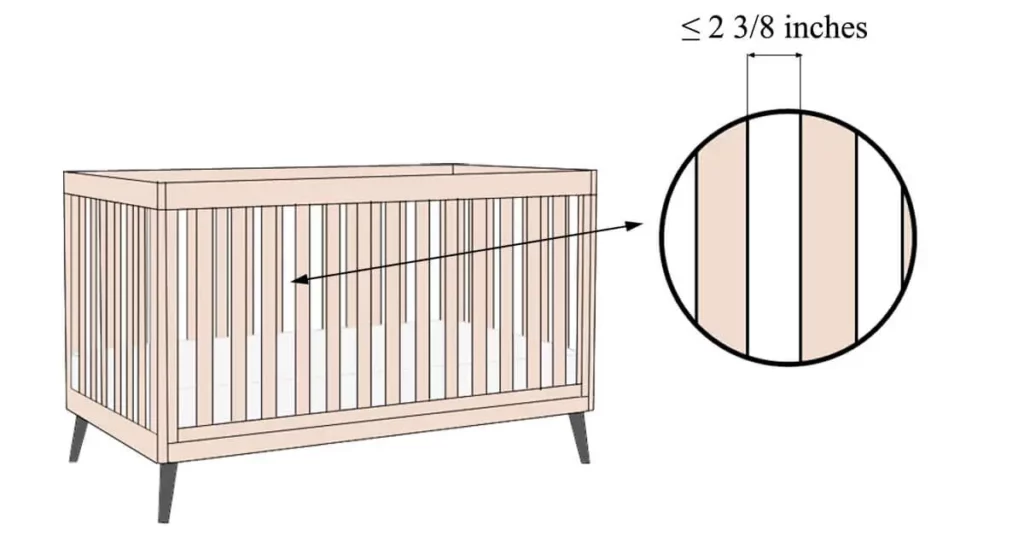
One of the most critical aspects of crib safety is the distance between the slats. Proper slat spacing prevents accidents and injuries, providing a secure environment for your baby. This guide addresses common questions about crib slat spacing, offering essential information to help you create a safe sleeping space for your baby.
What is the safe distance between crib slats?
According to guidelines from various safety organizations, including the Consumer Product Safety Commission (CPSC), the safe distance between crib slats should be no more than 2 3/8 inches (about 6 centimeters). This specific measurement is crucial to prevent infants from getting their heads, arms, or legs trapped between the slats, which can lead to severe injuries or even suffocation.
How was this distance determined?
The required spacing is set based on extensive research and testing. Such a distance is small enough to prevent a baby’s head from passing through but large enough to allow visibility and airflow. This balance is essential for the infant’s safety and comfort.
If slats are too far apart, there’s a risk of a baby’s head getting stuck. That can lead to strangulation or suffocation. If they are too close, that could restrict the baby’s view and airflow through the crib.
Should you check the space between the slats?
All cribs manufactured after June 28, 2011, must meet the updated safety standards set by the CPSC. These regulations also include the proper spacing between bars. Meaning cribs made after this date should meet these requirements.
However, it’s important to thoroughly inspect everything when it comes to the safety of our little one. Thus, we recommend you check the distance anyway. This step is crucial for older models, which may not adhere to the current safety regulations.
When it comes to keeping our little ones safe, every detail matters. I learned this firsthand when my nephew, Ethan, was born.
My sister got an antique crib from our grandmother. She was excited to use it for her new baby. The crib had a gorgeous design and meant a lot to our family.
We decided to check the crib’s safety features, including the distance between the slats. We used a tape measure to ensure the spacing was no more than 2 3/8 inches. To our dismay, we found that the slats were slightly over 3 inches apart. Although the crib had been safe in its time, it didn’t meet the modern safety standards.
We were unsure at first because of the crib’s emotional value. But after hearing a story from a close friend who had a scary experience with an old crib, we knew we couldn’t take any risks. In my friend’s case, their baby got his head stuck between the slats, which was a scary experience. Thankfully, the baby wasn’t hurt, but it had a lasting impact on their family.
We decided not to use the old crib. Instead, my sister bought a new one that meets the latest safety standards. Although it was a tough choice, it was the right one. Watching Ethan grow and sleep peacefully in a safe environment confirmed it a hundred times.
This experience showed how important it is to follow crib safety standards, especially the spacing between the slats. While it may be tempting to use a family heirloom, nothing is more important than keeping your baby safe.
If you ever face a similar situation, remember that modern safety standards are there for a reason. It’s best to put your baby’s safety first, even if it means setting aside sentimental items.
How can I measure the distance between crib slats?
To measure the distance between crib slats accurately, use a ruler or a tape measure. Place the measuring tool between two adjacent slats and check that the distance is no more than 2 3/8 inches (about 6 centimeters). For added accuracy, you can use a small card or piece of paper cut to the exact width to see if it fits through the slats.
What should you do if you find the slats are too far apart?
If you find that the slats of your crib are too far apart, it’s crucial to stop using the crib immediately. Do not attempt to modify or fix the slats yourself, as this could compromise the structural integrity of the crib. Instead, contact the manufacturer for advice or consider purchasing a new crib that meets the current safety standards.
Can using crib bumpers or other padding compensate for wider slat spacing?
No, using crib bumpers or padding is not recommended to compensate for wider slat spacing. In fact, the CPSC and other safety organizations advise against using crib bumpers due to the risk of suffocation, entrapment, and strangulation. The safest option is to ensure the crib meets the recommended slat spacing and avoid any additional padding inside the crib.
Are there any other safety features to look for in a crib?
Yes, besides the spacing of the slats, you should also look for:
- Sturdy construction with no loose parts
- A mattress that fits snugly within the crib without gaps
- No decorative cutouts or designs in the headboard or footboard that could trap a baby’s head or limbs
- Non-toxic finishes and paints
You can find more about current safety standards here: New CPSC Crib Safety Standards
